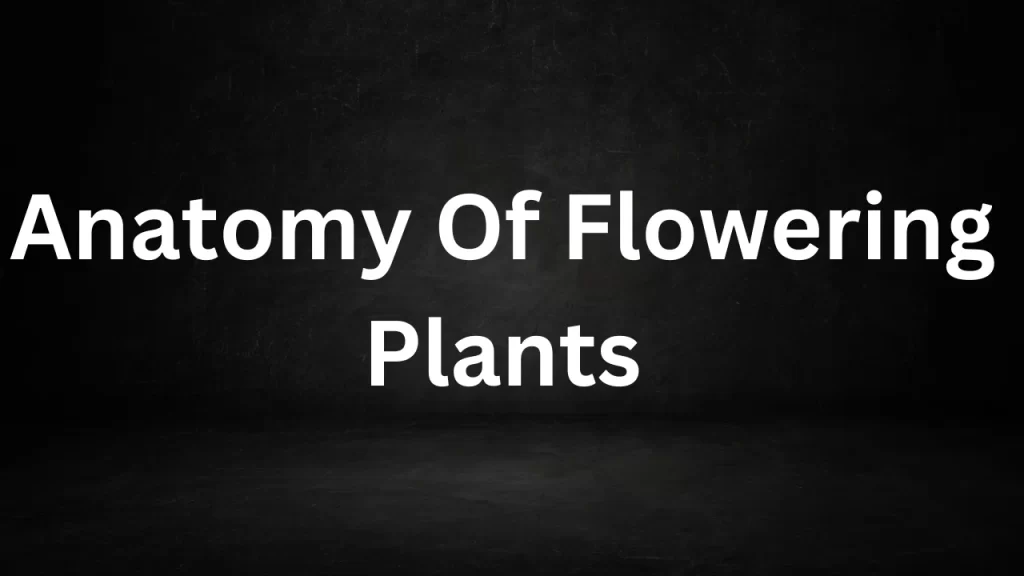Anatomy Of Flowering Plants
Anatomy Of Flowering Plants: The anatomy of flowering plants is a fascinating field of study that delves into the inner workings and structural complexity of these botanical wonders.
Flowering plants, also known as angiosperms, comprise the majority of plant species on Earth and play essential roles in ecosystems, agriculture, and our daily lives. In this article, we embark on a journey to explore the anatomy of flowering plants, from root to flower, uncovering the intricate structures that make these plants thrive and reproduce.
 Anatomy Of Flowering Plants
Anatomy Of Flowering Plants
The Root System
1. Roots: Roots anchor the plant in the soil and absorb water and nutrients. They often have a central taproot (primary root) with lateral roots branching off.
2. Root Cap: The root cap protects the delicate apical meristem (growing tip) as it pushes through the soil.
3. Root Hairs: Tiny hair-like structures on roots increase the surface area for water and nutrient absorption.
The Stem
4. Stem: The stem provides support for leaves, flowers, and fruits, and it conducts water, nutrients, and sugars throughout the plant.
5. Node: The node is the point on the stem where leaves, branches, or flowers are attached.
6. Internode: The internode is the stem segment between two nodes.
The Leaf
7. Leaf Blade: The broad, flat part of the leaf where photosynthesis occurs.
8. Petiole: The petiole is the leaf stalk that attaches the leaf blade to the stem.
9. Veins: Veins transport water, nutrients, and sugars within the leaf.
10. Leaf Margin: The leaf margin is the outer edge of the leaf, which can be smooth, serrated, or lobed.
The Flower
11. Flower: The reproductive structure of angiosperms, responsible for producing seeds. It typically consists of sepals, petals, stamens, and carpels.
12. Sepals: Sepals are the outermost floral parts, usually green, that protect the developing flower bud.
13. Petals: Petals are often colorful and serve to attract pollinators, such as bees and butterflies.
14. Stamens: Stamens are the male reproductive organs, consisting of anthers (where pollen is produced) and filaments.
15. Carpels: Carpels are the female reproductive organs, consisting of the stigma (where pollen is received), style, and ovary (containing ovules).
The Fruit
16. Fruit: The mature ovary of the flower, which contains seeds. Fruits serve as a means of seed dispersal.
17. Pericarp: The pericarp is the fruit wall, which can be fleshy (e.g., apple) or dry (e.g., bean pod).
The Vascular Tissues
18. Xylem: Xylem conducts water and minerals from the roots to the rest of the plant.
19. Phloem: Phloem transports sugars produced during photosynthesis from the leaves to other parts of the plant.
Specialized Structures
20. Meristems: Meristems are regions of undifferentiated cells where growth occurs. They are found at the tips of roots and stems.
21. Parenchyma, Collenchyma, and Sclerenchyma: These are different types of plant cells with various structural and support functions.
Understanding the anatomy of flowering plants is vital for horticulture, agriculture, and ecological studies. It allows us to cultivate crops, improve plant health, and appreciate the beauty and complexity of the natural world.
Whether you’re an aspiring botanist or simply an admirer of nature, exploring the intricate structures of flowering plants offers a deeper connection to the diverse plant life that surrounds us.
Read More
- Elastic Behaviour Of Materials
- Molecular Weight Of Oxalic Acid
- Structural Organisation In Animals
- CBSE Sample Papers for Class 11 English With Answers PDF
Frequently Asked Questions (FAQs) Anatomy Of Flowering Plants
What is the anatomy of a flowering plant?
The anatomy of a flowering plant encompasses its structural features, including roots, stems, leaves, flowers, and reproductive organs. It also involves specialized tissues like xylem and phloem for transport and meristems for growth.
What is the function of the root system in a plant?
The root system of a plant anchors it in the soil, absorbs water and nutrients, and stores reserve food materials.
How do leaves contribute to a plant’s survival?
Leaves are the primary sites for photosynthesis, where plants produce sugars using sunlight, carbon dioxide, and water. They also regulate transpiration, helping to maintain the plant’s water balance.
What role do stems play in a plant’s growth and development?
Stems provide structural support for leaves, flowers, and fruits. They also transport water, nutrients, and sugars throughout the plant.
What are the essential parts of a flower and their functions?
Flowers consist of sepals (protective outermost layer), petals (often colorful and attracting pollinators), stamens (male reproductive organs), and carpels (female reproductive organs). Their functions include reproduction and attracting pollinators.